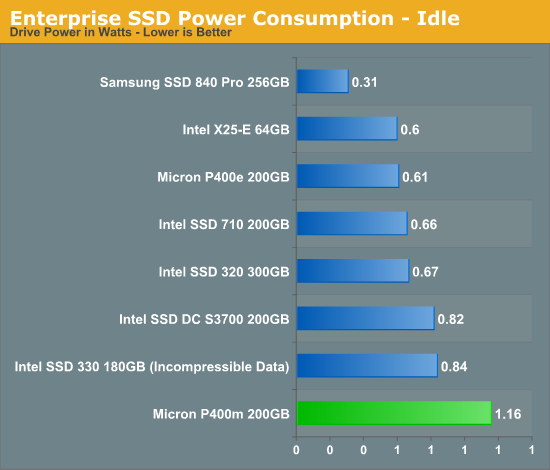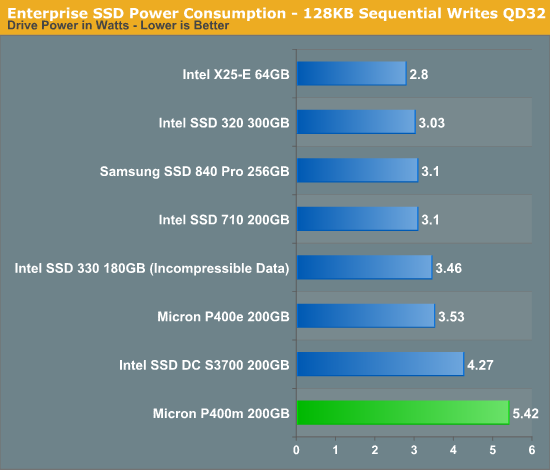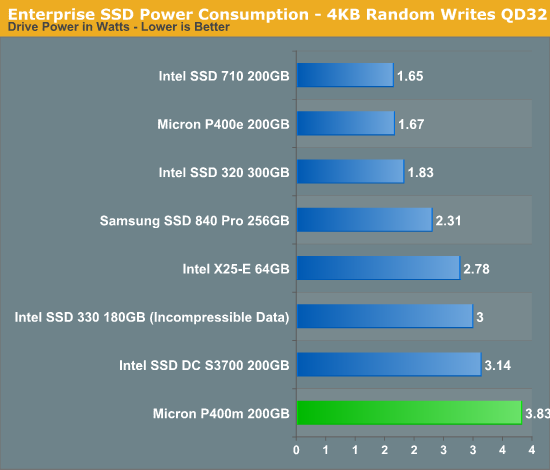Micron P400m Review (200GB)
by Anand Lal Shimpi on February 13, 2013 12:00 AM ESTPower Consumption
Power consumption for enterprise drives isn't as sensitive as it is in the mobile space. The P400m ends up being the most power hungry drive here, but even in its worst case the P400m is still better off than a high-end enterprise mechanical drive.













23 Comments
View All Comments
philipma1957 - Wednesday, February 13, 2013 - link
I missed the warranty on this drive was it 3 or 5 years?Beenthere - Wednesday, February 13, 2013 - link
The warranty doesn't matter much because if you need to use it, you'll get a repaird unit that isn't likely to last 1 year based on many people's experience. The lost data is the real issue for most people...For those who don't know, now days a longer product warranty does not decree a better quality product. Products with longer warranty cost more to pay for the longer warranty.
designerfx - Wednesday, February 13, 2013 - link
I don't get your point? The point of a warranty is to guarantee performance up to the stated warranty period. That's never been about quality or not. Whether you get a good unit back from warranty is entirely going to be luck of the draw with any manufacturer.It's no different in the car industry, Hyundai's 10 year warranty isn't an indicator of quality either.
peterfares - Wednesday, February 13, 2013 - link
I think his point is that because its an enterprise drive and because warranty replacements are unreliable, they wouldn't be put into service in an enterprise environment.DuckieHo - Thursday, February 14, 2013 - link
Why would an enterprise replacement be unreliable? Hardware fails... that's why there's a warranty in the first place.Not replacing the drive or using a different drive would absolutely be more risky to uptime.
JellyRoll - Wednesday, February 13, 2013 - link
I googled to find more data on this "XPERT NAND" that is mentioned in this article. It actually doesn't exist, though a PDF explains that XPERT is not NAND, it is actual firmware and algorithms. I can't believe Anand missed the mark so badly.Anand Lal Shimpi - Wednesday, February 13, 2013 - link
It's a combination of NAND binning/tech, firmware and validation. From Micron's reviewer's guide on the P400m:"The P400m is built from the ground up with custom 25nm MLC NAND that uses Micron’s extended performance and enhanced reliability technology (XPERT)."
JellyRoll - Wednesday, February 13, 2013 - link
Well..that states specifically that it uses XPERT technology but not that the NAND is XPERT NAND.For instance, some Marvell SSDs use F.R.A.M.E. technology, but they do not refer to it as F.R.A.M.E. NAND.
mmonnin03 - Thursday, February 14, 2013 - link
All the NAND is pretty much the same. The only thing really different with the NAND is binning during probe. A fuse blown here, a fuse blown there. Fab process is the same.If its 42GBit chips like the article mentioned then these are the TLC designed chips but only storing 2 bits in a Cell. 2/3 of 64GBit chip = 43GBit.
JellyRoll - Wednesday, February 13, 2013 - link
Its weird but I noticed when this article posted that there were already 1,394 likes in the icon above. I come back three hours later and there is the exact same number of likes! It really blew my mind that there would be 1,394 likes in the first five minutes of this article being posted, but now i see that the Like button must be broken :)